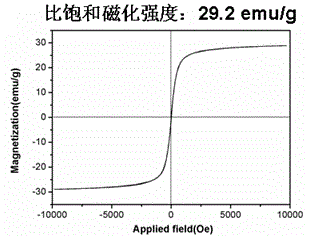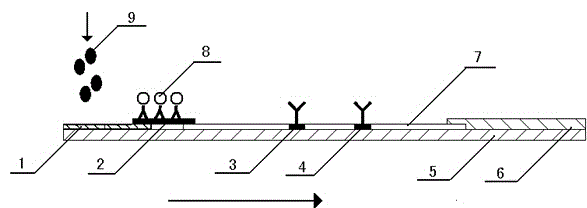Magnetic nanoparticle biological probe, preparation method and application thereof
A technology of magnetic nanoparticles and biological probes, applied in the fields of biotechnology and nanomaterials, can solve the problems of high cost of detection experiments, inability to quantitatively detect HBV, and long time consumption.
- Summary
- Abstract
- Description
- Claims
- Application Information
AI Technical Summary
Problems solved by technology
Method used
Image
Examples
Embodiment 1
[0073] Example 1 magnetic nanoparticles
[0074] A method for preparing magnetic nanoparticles, comprising the steps of:
[0075] (1) Prepare magnetic particles by solvothermal method: Dissolve 0.85g FeCl3 6H2O and 0.4033g PAA in 40ml ethylene glycol respectively, then add 1.2g urea to dissolve, mix and add to a stainless steel reactor with tetrafluoroethylene liner In the process, tighten the reactor, heat and react at 220°C for 16 hours, and wash with ethanol and deionized water three times with the assistance of magnetic separation to obtain magnetic particles with an average particle size of 90nm;
[0076] (2) Silicon oxide-coated magnetic particles: Mix 90 mg of magnetic particles with 1.0 mol / L hydrochloric acid solution, sonicate for 30 minutes, wash 5 times with deionized water under the assistance of magnetic separation, and then mix the magnetic particles with alcohol water volume Mix 125 mL of alcohol-water mixture with a ratio of 70:30, add 200 μL of tetraethyl...
Embodiment 2
[0078] Example 2 magnetic nanoparticles
[0079] A method for preparing magnetic nanoparticles, comprising the steps of:
[0080] (1) Prepare magnetic particles by solvothermal method: Dissolve 0.81g FeCl3 6H2O and 2.66g sodium citrate in 30ml ethylene glycol respectively, mix them and add them to a stainless steel reaction kettle with a tetrafluoroethylene liner, tighten the reaction Kettle, heated and reacted at 200°C for 24 hours, washed with ethanol and deionized water three times with the assistance of magnetic separation, to obtain magnetic particles with an average particle size of 250 nm;
[0081] (2) Silicon oxide-coated magnetic particles: Mix 110 mg of magnetic particles with 1.0 mol / L hydrochloric acid solution, sonicate for 15 minutes, wash with deionized water for 7 times with the assistance of magnetic separation, and then mix the magnetic particles with alcohol water volume Mix 125 mL of alcohol-water mixture with a ratio of 90:10, add 100 μL of tetraethyl ...
Embodiment 3
[0083] Example 3 Magnetic Nanoparticle Bioprobes
[0084] A method for preparing a magnetic nanoparticle bioprobe, comprising the steps of:
[0085] Step 1) Add 15 mg of the magnetic nanoparticles prepared in Example 1 or 2 to 50 g of ethanol aqueous solution with a volume ratio of alcohol to water of 70:30, add 50 μL of ammonia water and 35 μL of aminopropyltriethoxysilane, and stir for 2 hours at room temperature , continue to stir for 3 hours in a water bath at 70°C, wash with ethanol to obtain surface-aminated magnetic nanoparticles; mix the surface-aminated magnetic nanoparticles with dimethyl sulfoxide (DMSO), add 5.5 mg of succinic anhydride to react for 24 hours , washed three times with DMSO under the assistance of magnetic separation, and then washed three times with deionized water to obtain surface carboxylated magnetic nanoparticles, the carboxyl content of these surface carboxylated magnetic nanoparticles is 0.9-1.5mmol / g;
[0086] Step 2) Wash 2 mg of surfac...
PUM
| Property | Measurement | Unit |
|---|---|---|
| particle diameter | aaaaa | aaaaa |
| thickness | aaaaa | aaaaa |
| width | aaaaa | aaaaa |
Abstract
Description
Claims
Application Information
 Login to View More
Login to View More - R&D
- Intellectual Property
- Life Sciences
- Materials
- Tech Scout
- Unparalleled Data Quality
- Higher Quality Content
- 60% Fewer Hallucinations
Browse by: Latest US Patents, China's latest patents, Technical Efficacy Thesaurus, Application Domain, Technology Topic, Popular Technical Reports.
© 2025 PatSnap. All rights reserved.Legal|Privacy policy|Modern Slavery Act Transparency Statement|Sitemap|About US| Contact US: help@patsnap.com



